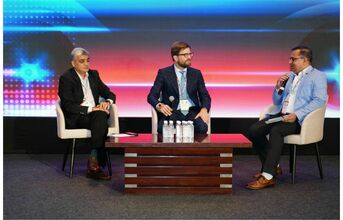
This panel delved into ‘Designing Sustainable and Aesthetically Pleasing Vehicles', an area of discussion that impresses many but is mastered by a few. Panellists Dr. Sandeep Waykole, India Business Director and Global Programme Director, Faurecia Clairon Electronics India Pvt. Ltd., and Christopher Stillings, Head CMF Global, Covestro, delved into the topic as Jaiprakash Ramani, Chief Marketing Officer, Supreme Group, Automotive BU, led the discussion as its moderator.
Ramani initiated the conversation by addressing the contrasting nature of design and sustainability. He asked Stillings about how he navigates the tension between the free flow of ideas in design and the necessity to operate within constraints when considering sustainability.
According to Stillings, constraints are inherent in the utilisation of materials for specific applications due to their nature and characteristics.
He went on to say that "there is no perfect material" and so there are always certain compromises made, and certain attributes of that plastic are prioritised. This complexity only gets heightened when one deals with recycled materials, which limits design and aesthetic options.
In areas like colouring, this can be more challenging or even impossible. Further, mechanical recycling also brings in a damage of polymer chains, and mechanical properties may not remain the same.
He recommended the need to conduct dialogues and educate people, which will push the boundaries of these constraints and give designers commercialised, producible materials in their hands and a certain playing field that they should aim to keep expanding.
Dr. Waykole explained that there is a form of checklist that is followed when it comes to design; this includes cost, process, and material; sustainability must be added to this mandatory list and shouldn't be evaded.
The first step, according to him, is to understand what sustainability is. He explained that there's a lot more layering to it than making a jump to bio-based or environment-friendly materials. The most important factor is that the material must be available in local areas.
The second factor is to process the material with minimum energy and environmental impact, and amidst all this, the selected material must also be cost-effective. "If you have a biodegradable material coming from Europe through sea or air, there is a lot of carbon footprint involved in the travel," ultimately rendering the objective of sustainability futile, he explained.
As a call to action, he recommended raising awareness among designers, who just a decade ago made the shift from metal to plastic and are now expected to shift from plastic to sustainable plastic.
Ramani then posed the core question of the conversation: "What comes first? Design or sustainability?" Dr. Waykole shared that due to the lack of awareness and the fact that the sustainability market has not yet reached its potential, the focus is still on designing.
However, he added that there are two approaches: a design-based approach and a sustainable-based approach. While the automotive industry largely tilts towards design, now there are certain components where people prioritise sustainability.
As a raw material supplier, Christopher said that they get a variety of customers; some of them have a design ready and want to inculcate sustainability at least somewhere in the interiors; on the other hand, those who are coming up with entirely new models, generations, or are working with electric vehicles prefer to really think it through.
Continue Reading on Page 2


























